
[Last Update: June 28th, 2018]

|
X-Philes
Hypobarotolerant
Copyright © 2018 by Dustin Jon Scott
[Last Update: June 6th, 2018]
Abstract
III.a-1.) Trends in Specializations of Prokaryotic Extremophiles
If the Archaea evolved on Earth as the Bacteria were evolving on Mars, and there was occasional cross-contamination which intensified during the LHB, then we should expect extremophiles which specialize in tolerating spacial extremes, like cold, drouth, low pressure, radioactivity, hyperacceleration and hypergravity, to be found mostly among the Bacteria, while extremophiles among the Archaea should be expected more often to specialize in tolerating decidedly planetary extremes such as heat, high pressure, acidity, salinity, and alkalinity.
II.a-1A.) Adaptations to Terrestrial Extremes
III.a-1Aα.) Acidophiles & Hyperacidotolerant, Near-Acidophilic Neutriphiles
This group includes organisms capable of thriving in hyperacidic conditions, most of which have an optimal growth pH of 5 or lower (OGpH<5), although a few have an OGpH slightly above this (e.g., Nanoarchaeum equitans, OGpH=6) but can nonetheless be found flourishing in hyperacidic environments (pH=0.5-1.5).
Described Genera
| Domain |
Genus |
Source |
Ratio |
N>H0 |
Archaea
27/43
(62.79%)
|
Acidianus |
Johnson, 1998; Zhang et al., 2015 |
27:16 |
5.5 (25.58%) |
| Acidiplasma |
Zhang et al., 2015 |
| Aenigmarchaeum |
Golyshina et al., 2017 |
| Cuniculiplasma |
Golyshina et al. 2016 |
| Ferroplasma |
Dopson et al.2003; Zhang et al., 2015 |
| Halarchaeum |
() |
| Candidatus Haloredivivus |
Golyshina et al., 2017 |
| Candidatus Lainarchaeum |
Golyshina et al., 2017 |
| Candidatus Mancarchaeum |
() |
| Metallosphaera |
Johnson, 1998 |
| Candidatus Micrarchaeum |
Baker et al., 2010 |
| Nanoarchaeum |
Golyshina et al., 2017 |
| Nanobsidianus |
|
| Nanopusillus |
|
| Candidatus Nanosalina |
Golyshina et al., 2017 |
| Candidatus Nanosalinarum |
Golyshina et al., 2017 |
| Nitrosopumilus |
Lehtovirta-Morley et al., 2014 |
| Nitrosotalea |
Lehtovirta-Morley et al., 2011 2014) |
| Candidatus Parvarchaeum |
Baker et al., 2010 |
| Picrophilus |
Rampelotto, 2013, Johnson, 1998; Zhang et al., 2015 |
| Stygiolobus |
Johnson, 1998 |
| Sulfolobus |
Johnson, 1998; Zhang et al., 2015 |
| Sulfurisphaera |
() |
| Sulfurococcus |
Johnson, 1998 |
| Thermogymnomonas |
() |
| Thermoplasma |
Johnson, 1998; Zhang et al., 2015 |
Bacteria
16/43
(37.21%) |
Acetobacter |
Johnson, 1998 |
| Acidiphilium |
Johnson, 1998; Fashola et al., 2015 |
Acidithiobacillus |
Johnson, 1998 |
| Acidobacterium |
Johnson, 1998 |
| Acidimicrobium |
Johnson, 1998 |
| Acidocella |
Johnson, 1998; Fashola et al., 2015 |
| Acidomonas |
Johnson, 1998 |
| Alicyclobacillus |
Johnson, 1998; Fashola et al., 2015 |
| Bryocella |
() |
| Ferrimicrobium |
Johnson, 1998 |
| Helicobacter |
|
| Leptospirillum |
Johnson, 1998; Lehtovirta-Morley et al., 2014 |
| Sulfobacillus |
Johnson, 1998; Fashola et al., 2015 |
| Telmatobacter |
() |
| Thiobacillus |
Johnson, 1998 |
| Thiomonas |
Johnson, 1998 |
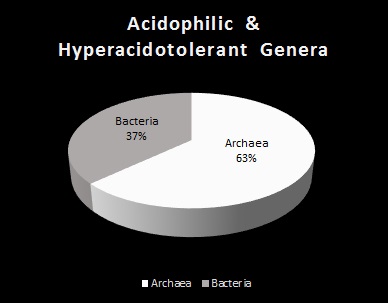
Generic goodness-of-fit
| Domain | Observed | H0 | O-H0 | (O-H0)2 | (O-H0)2/H0 |
| Archaea | 27/43 (62.79%) | 21.5/43 (50%) | 5.5 (12.79%) | 30.25 (163.60%) | 1.406976744186047 (3.27%) |
| Bacteria | 16/43 (37.21%) | 21.5/43 (50%) | -5.5 (-12.79%) | 30.25 (163.60%) | 1.406976744186047 (3.27%) |
| X2= | 2.813953488372094 |
| Df= | 1 |
| α/2= | ? |
| X2CV= | ? |
Described Species
| Domain |
Genus & Species |
OGpH |
pH range |
Source |
Ratio |
N(50%)>H0 |
Archaea
86/124
(69%)
|
Acidianus ambivalens |
2.5 |
1-3.5 |
Johnson, 1998; Zhang et al., 2015 |
86:38 |
38% |
| Acidianus brierleyi |
1.5-2 |
1-6 |
Johnson, 1998; Edwards et al., 2000; Fashola et al., 2015; Zhang et al., 2015 |
| Acidianus convivator |
<4 |
? |
() |
Acidianus copahuensis |
2.5-3 |
1-5 |
Zhang et al., 2015 |
| Acidianus infernus |
2 |
1-5.5 |
Johnson, 1998; Zhang et al., 2015 |
| Acidianus manzaensis |
1.2-2.5 |
1-5 |
Ding et al. 2011; Zhang et al., 2015 |
| Acidianus pozzuoliensis |
|
? |
|
| Acidianus sulfidivorans |
0.8-1.4 |
0.35-3 |
Plumb et al. 2007; Zhang et al., 2015 |
| Acidianus tengchongensis |
1.5-2.5 |
1-5.5 |
He et al. 2004; Zhang et al., 2015 |
| Acidianus sp. DSM 29099 |
? |
? |
Zhang et al., 2015 |
| Acidianus sp. RZ1 |
? |
? |
Zhang et al., 2015 |
| Acidiplasma aeolicum |
1.4-1.6 |
0-4 |
Zhang et al., 2015 |
| Acidiplasma cupricumulans |
1-1.2 |
0.4-1.8 |
Zhang et al., 2015 |
| Candidatus Aenigmarchaeum subterraneum |
0.5-1.5 |
? |
Baker et al., 2006; Golyshina et al., 2017 |
| Candidatus Cenarchaeum symbiosum A |
<4 |
? |
Herbold et al., 2017 |
| Cuniculiplasma divulgatum |
1-1.2 |
? |
Golyshina et al. 2016 |
| Ferroplasma acidarmanus |
1.2 |
0-2.5 |
Edwards et al., 2000, Dopson et al.2003; Zhang et al., 2015 |
| Ferroplasma acidiphilum |
1.7 |
1.3-2.2 |
Fashola et al., 2015; Zhang et al., 2015 |
| Ferroplasma acidiphilum BRGM4 |
? |
? |
Zhang et al., 2015 |
| Ferroplasma cyprexacervatum |
<4 |
? |
() |
| Ferroplasma thermophilum |
1 |
0.2-2.5 |
Zhang et al., 2015 |
| Halarchaeum acidiphilum |
<4 |
? |
() |
| Candidatus Haloredivivus sp. |
0.5-1.5 |
? |
Baker et al., 2006; Golyshina et al., 2017 |
| Candidatus Lainarchaeum andersonii |
0.5-1.5 |
? |
Baker et al., 2006; Golyshina et al., 2017 |
| Candidatus Mancarchaeum acidiphilum |
0.5-1.5 |
? |
Baker et al., 2006; Golyshina et al., 2017 |
| Metallosphaera cuprina |
3.5 |
2.5-5.5 |
Zhang et al., 2015 |
| Metallosphaera hakonensis |
3 |
1-4 |
Zhang et al., 2015 |
| Metallosphaera prunae |
2 |
1-4.5 |
Johnson, 1998; Zhang et al., 2015 |
| Metallosphaera sedula |
2 |
1-4.5 |
Johnson, 1998; Fashola et al., 2015; Zhang et al., 2015 |
| Metallosphaera yellowstonensis |
2-3 |
1-4.5 |
Zhang et al., 2015 |
| Candidatus Micrarchaeum acidiphilum |
0.5-1.5 |
? |
Baker et al., 2006; Baker et al., 2010; Golyshina et al., 2017 |
| Candidatus Nanoarchaeum equitans |
6*; 0.5-1.5 |
? |
Baker et al., 2006; Baker et al., 2010; Golyshina et al., 2017 |
| Nanobsidianus stetteri |
|
? |
|
| Nanopusillus acidilobi sp. |
|
? |
|
| Candidatus Nanosalina sp. |
0.5-1.5 |
? |
Baker et al., 2006; Baker et al., 2010; Golyshina et al., 2017 |
| Candidatus Nanosalinarum sp. |
0.5-1.5 |
? |
Baker et al., 2006; Baker et al., 2010; Golyshina et al., 2017 |
| Candidatus Nitrosoarchaeum koreensis |
<4 |
? |
Herbold et al., 2017 |
| Candidatus Nitrosoarchaeum limnia |
<4 |
? |
Herbold et al., 2017 |
| Candidatus Nitrosoarchaeum limnia |
<4 |
? |
Herbold et al., 2017 |
| Candidatus Nitrosocosmicus oleophilus |
<4 |
? |
Herbold et al., 2017 |
| Candidatus Nitrosopelagicus brevis |
<4 |
? |
Herbold et al., 2017 |
| Candidatus Nitrosopumilus maritimus |
<4 |
? |
Lehtovirta-Morley et al., 2014; Herbold et al., 2017 |
| Candidatus Nitrosopumilus viennensis |
<4 |
? |
Lehtovirta-Morley et al., 2014 |
| Candidatus Nitrosopumilus sp. SJ |
<4 |
? |
Herbold et al., 2017 |
| Candidatus Nitrosopumilus sp. NF5 |
<4 |
? |
Herbold et al., 2017 |
| Candidatus Nitrosopumilus sp. AR1 |
<4 |
? |
Herbold et al., 2017 |
| Candidatus Nitrosopumilus sp. AR2 |
<4 |
? |
Herbold et al., 2017 |
| Candidatus Nitrosopumilus salaria |
<4 |
? |
Herbold et al., 2017 |
| Candidatus Nitrosopumilus sp. D3C |
<4 |
? |
Herbold et al., 2017 |
| Candidatus Nitrososphaera evergladensis |
<4 |
? |
Herbold et al., 2017 |
| Candidatus Nitrososphaera viennensis |
<4 |
? |
Herbold et al., 2017 |
| Candidatus Nitrososphaera gargensis |
<4 |
? |
Herbold et al., 2017 |
| Candidatus Nitrosotalea okcheonensis |
<4 |
? |
Herbold et al., 2017 |
| Candidatus Nitrosotalea sinensis |
<4 |
? |
Herbold et al., 2017 |
| Candidatus Nitrosotalea devanaterra |
4-5 |
? |
Lehtovirta-Morley et al., 2011 & 2014; Herbold et al., 2017 |
| Candidatus Nitrosotalea bavarica |
<4 |
? |
Herbold et al., 2017 |
| Candidatus Nitrosotenuis uzonensis |
<4 |
? |
Herbold et al., 2017 |
| Candidatus Nitrosotenuis chungbukensis |
<4 |
? |
Herbold et al., 2017 |
| Candidatus Nitrosotenuis cloacae |
<4 |
? |
Herbold et al., 2017 |
| Candidatus Parvarchaeum acidiphilum |
0.5-1.5 |
? |
Baker et al., 2006; Baker et al., 2010; Golyshina et al., 2017 |
| Candidatus Parvarchaeum acidophilus |
0.5-1.5 |
? |
Baker et al., 2006; Baker et al., 2010; Golyshina et al., 2017 |
| Picrophilus sp. |
1 |
? |
(Baker-Austin & Dopson, 2007) |
| Picrophilus oshimae |
0.7-2.2 |
≥0-3.5 |
Rampelotto, 2013, Johnson, 1998 |
| Picrophilus torridus |
0.06-0.07 |
≥0-3.5 |
Rampelotto, 2013, Johnson, 1998; Zhang et al., 2015 |
| Stygiolobus azoricus |
2.5-3 |
1-5.5 |
Johnson, 1998; Zhang et al., 2015 |
| Sulfolobus acidocaldarius |
2-3 |
1-5.9 |
Johnson, 1998; Edwards et al., 2000; Zhang et al., 2015 |
| Sulfolobus hakonensis |
<3 |
? |
Johnson, 1998 |
| Sulfolobus islandicus |
<4 |
? |
() |
| Sulfolobus metallicus |
? |
1-4.5 |
Johnson, 1998; Fashola et al., 2015; Zhang et al., 2015 |
| Sulfolobus mirabilis |
<3 |
? |
Johnson, 1998 |
| Sulfolobus neozealandicus |
? |
? |
() |
Sulfolobus rivotinct |
? |
? |
Zhang et al., 2015 |
| Sulfolobus shibatae |
3 |
? |
Johnson, 1998; Zhang et al., 2015 |
| Sulfolobus solfataricus |
3 |
2-4 |
Johnson, 1998, Dopson (2003); Zhang et al., 2015 |
| Sulfolobus tengchongensis |
3.5 |
1.7-6.5 |
Zhang et al., 2015 |
| Sulfolobus thuringiensis |
? |
? |
() |
| Sulfolobus tokodaii |
2.5-3 |
2-5 |
Dopson 2003; Zhang et al., 2015 |
| Sulfolobus yangmingensis |
4 |
2-6 |
Zhang et al., 2015 |
| Sulfurisphaera ohwakuensis |
2 |
1-5 |
Zhang et al., 2015 |
| Sulfurococcus mirabilis |
2-2.6 |
1-5.8 |
Zhang et al., 2015 |
| Sulfurococcus yellowstonensis |
2-2.6 |
1-5.5 |
Zhang et al., 2015 |
| Sulfurococcus yellowstonii |
? |
? |
Johnson, 1998 |
| Thermococcus celer |
5.8 |
? |
Zhang et al., 2015 |
| Thermogymnomonas acidocola |
3 |
1.8-4 |
Zhang et al., 2015 |
| Thermoplasma acidophilum |
1.8 |
0.5-4 |
Johnson, 1998; Zhang et al., 2015 |
| Thermoplasma volcanium |
2 |
1-4 |
Johnson, 1998; Zhang et al., 2015 |
Bacteria
38/124
(31%) |
Acetobacter aceti |
|
? |
Johnson, 1998 |
Acidiphilium acidophilum
(Thiobacillus acidophilus) |
<3 |
? |
Johnson, 1998 |
| Acidiphilium multivorum |
<3 |
? |
(Dopson 2003) |
Acidithiobacillus albertensis
(Thiobacillus albertis) |
<3 |
? |
Johnson, 1998; Fashola et al., 2015 |
Acidithiobacillus caldus
(Thiobacillus caldus) |
<3 |
? |
Johnson, 1998;
Fashola et al., 2015; Zhang et al., 2015 |
| Acidithiobacillus ferridurans |
<4 |
? |
() |
| Acidithiobacillus ferriphilus |
<4 |
? |
() |
| Acidithiobacillus ferrivorans |
<4 |
? |
(Fashola et al., 2015) |
Acidithiobacillus ferro(o)xidans
(Thiobacillus ferrooxidans) |
<3 |
? |
Johnson, 1998; Fashola et al., 2015; Zhang et al., 2015 |
Acidithiobacillus thioxidans
(Thiobacillus thioxidans) |
<3 |
? |
Johnson, 1998; Fashola et al., 2015; Zhang et al., 2015 |
| Acidobacterium capsulatum |
<3 |
? |
Johnson, 1998; Fashola et al., 2015 |
| Acidimicrobium ferroxidans |
<3 |
? |
Johnson, 1998; Fashola et al., 2015 |
| Acidocella spp. |
<3 |
? |
Johnson, 1998 |
| Acidomonas methanolica |
<3 |
? |
Johnson, 1998 |
| Alicyclobacillus thermosulfidooxidans |
<3 |
? |
Johnson, 1998 |
Alicyclobacillus thermosulfidooxidans
(Sulfobacillus thermosulfidooxidans) |
<3 |
? |
Johnson, 1998; Fashola et al., 2015; Zhang et al., 2015 |
| Bryocella elongata |
<4 |
? |
() |
| Ferrimicrobium acidiphilum |
<3 |
? |
Johnson, 1998 |
| Ferrimicrobium acidiphilus |
<3 |
? |
Fashola et al., 2015 |
| Gallionella ferruginea |
|
? |
(Fashola et al., 2015) |
| Helicobacter pylori |
|
? |
|
| Hydrogenobacter acidophilus |
|
? |
(Fashola et al., 2015) |
| Leptospirillum ferriphilum |
<3 |
? |
Lehtovirta-Morley et al., 2014; Zhang et al., 2015 |
| Leptospirillum ferro(o)xidans |
<3 |
? |
Johnson, 1998; Fashola et al., 2015; Zhang et al., 2015 |
| Leptospirillum thermoferrooxidans |
<3 |
? |
Johnson, 1998 |
| Sulfobacillus acidophilus |
<3 |
? |
Johnson, 1998; Fashola et al., 2015 |
| Telmatobacter bradus |
<4 |
? |
() |
| Thiobacillus acidophilus |
<4 |
? |
() |
| Thiobacillus dentrificans |
|
? |
(Fashola et al., 2015) |
| Thiobacillus organovorus |
<4 |
? |
() |
| Thiobacillus prosperus |
<3 |
? |
Johnson, 1998 |
Thiomonas cuprina
(Thiobacillus cuprinus) |
<3 |
? |
Johnson, 1998 |
| Desulfovibrio sp. |
? |
? |
Fashola et al., 2015 |
Desulfomicrobium sp. |
? |
? |
Fashola et al., 2015 |
Desulfobulbus sp. |
? |
? |
Fashola et al., 2015 |
Desulfosarcina sp. |
? |
? |
Fashola et al., 2015 |
Desulfobacter sp. |
? |
? |
Fashola et al., 2015 |
Desulfotomaculum sp. |
? |
? |
Fashola et al., 2015 |

Specific goodness-of-fit
| Domain | Observed | Expected | O-E | (O-E)2 | (O-E)2/E |
| Archaea | 86 | 62 | 24 | 576 | 9.2903225806451 |
| Bacteria | 38 | 62 | -24 | 576 | 9.2903225806451 |
| Df= | 1 |
| X2 crit= | 3.41 |
| X2= | 18.5806451612902 |
Specific % goodness-of-fit
| Domain | Observed % | Expected % | O-E | (O-E)2 | (O-E)2/E |
| Archaea | 69 | 50 | 19 | 361 | 7.22 |
| Bacteria | 31 | 50 | -19 | 361 | 7.22 |
| Df= | 1 |
| X2 crit= | 3.41 |
| X2= | 14.44 |
Ding et al., 2011
Dopson et al., 2003
Baker et al., 2010
Plumb et al., 2007
Whitman et al., 1999
"Nitrosotalea is an abundant, globally distributed genus of AOA found in acidic soils (Gubry-Rangin et al., 2011). Thirty per cent of the world's soils are considered acidic (pH < 5.5; von Uexküll & Mutert, 1995), and ammonia oxidation in low pH soils is dominated by AOA, rather than AOB (Gubry-Rangin et al., 2010; Lehtovirta-Morley et al., 2011)."
Craig W. Herbold, Laura E. Lehtovirta-Morley, Man-Young Jung, Nico Jehmlich, Bela Hausmann, Ping Han, Alexander Loy, Michael Pester, Luis A. Sayavedra-Soto, Sung-Keun Rhee, James I. Prosser, Graeme W. Nicol, Michael Wagner and Cecile Gubry-Rangin. Ammonia-oxidising archaea living at low pH: Insights from comparative genomics. Environmental Microbiology (2017) 19(12), 4939–4952
III.a-1Aβ.) Alkaliphiles
Described Genera
| Domain |
Genus & Species |
A |
B |
Ratio |
%>H0 |
| Archaea |
Halalkalicoccus |
15/16 (93.75%) |
1/16 (6.25%) |
87.5% |
16:1 |
| Haloarcula |
| Halobaculum |
| Halobiforma |
| Haloferax |
| Halorubrum gandharaense |
| Nanobacterium gregoryi |
| Natronococcus amylolyticus |
| Natronococcus jeotgali |
| Natronococcus occultus |
| Natronolimnobius |
| Natronomonas pharaonis |
| Natronorubrum |
| Thermococcus alkaliphilus |
| Thermococcus acidaminovorans |
| Methanohalophilus |
| Bacteria |
(Coming Soon) |
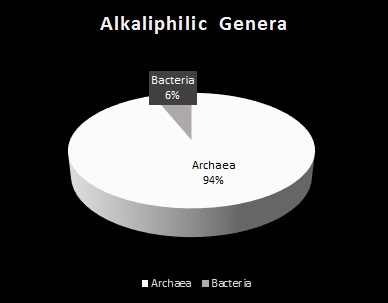
Described Species
| Domain |
Genus & Species |
A |
B |
Ratio |
%>H0 |
| Archaea |
Halalkalicoccus |
15/16 (93.75%) |
1/16 (6.25%) |
16:1 |
87.5% |
| Haloarcula |
| Halobaculum |
| Halobiforma |
| Haloferax |
| Halorubrum gandharaense |
| Nanobacterium gregoryi |
| Natronococcus amylolyticus |
| Natronococcus jeotgali |
| Natronococcus occultus |
| Natronolimnobius |
| Natronomonas pharaonis |
| Natronorubrum |
| Thermococcus alkaliphilus |
| Thermococcus acidaminovorans |
| Methanohalophilus |
| Bacteria |
(Coming Soon) |
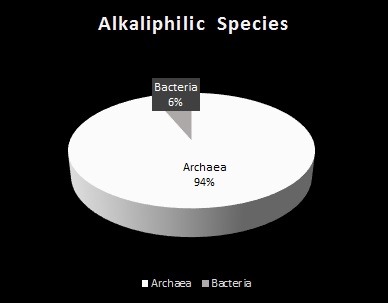
Elis Watanable Nogueira, Elize Ayumi Hayash, Enne Alves, Claudio Antônio de Andrade Lima, Maria Talarico Adorno, Gunther Brucha. Characterization of Alkaliphilic Bacteria Isolated from Bauxite Residue in the Southern Region of Minas Gerais, Brazil. Brazilian Archives of Biology and Technology vol.60 Curitiba 2017 Epub May 11, 2017
http://dx.doi.org/10.1590/1678-4324-2017160215
III.a-1Aγ.) Barophiles
| Domain |
Genus |
Ratio |
σ |
ρ |
%>H0 |
| Archaea |
Pyrococcus |
1:1 |
1/2 (50%) |
1/2 (50%) |
0% |
| Bacteria |
Salinicola |
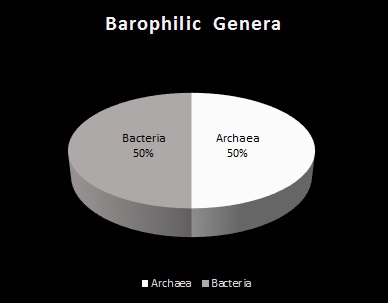
| Domain |
Genus & Species |
Ratio |
σ |
ρ |
%>H0 |
| Archaea |
Pyrococcus abyssi |
6:1 |
1/7 (14%) |
6/7 (86%) |
72% |
| Pyrococcus endeavori |
| Pyrococcus furiosis |
| Pyrococcus glycovorans |
| Pyrococcus horikoshii |
| Pyrococcus woesei |
| Bacteria |
Salinicola salarius |
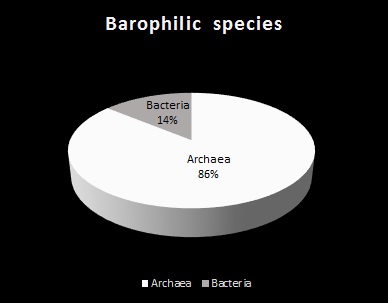
(Gareeb & Setati, 2009)
(Pikuta et al., 2017)
III.a-2Aδ.) Halophiles
| Domain |
Genus & Species |
Ratio |
σ |
ρ |
%>H0 |
| Archaea |
Pyrococcus abyssi |
6:1 |
1/7 (14%) |
6/7 (86%) |
72% |
| Pyrococcus endeavori |
| Pyrococcus furiosis |
| Pyrococcus glycovorans |
| Pyrococcus horikoshii |
| Pyrococcus woesei |
| Bacteria |
Salinicola salarius |

| Domain |
Genus & Species |
Ratio |
σ |
ρ |
%>H0 |
| Archaea |
Blank |
1:1 |
1/2 (50%) |
1/2 (50%) |
0% |
| Bacteria |
Blank |
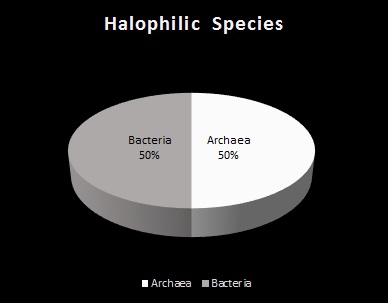
II.c-1Aε.) Haloalkaliphiles
| Domain |
Genus & Species |
Ratio |
σ |
ρ |
%>H0 |
| Archaea |
Blank |
1:1 |
1/2 (50%) |
1/2 (50%) |
0% |
| Bacteria |
Blank |
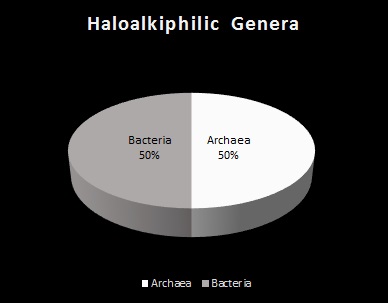
| Domain |
Genus & Species |
Ratio |
σ |
ρ |
%>H0 |
| Archaea |
Blank |
1:1 |
1/2 (50%) |
1/2 (50%) |
0% |
| Bacteria |
Blank |
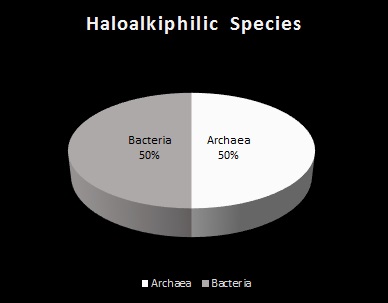
III.a-2Aζ.) Hyperthermophiles
| Domain |
Genus & Species |
Ratio |
σ |
ρ |
%>H0 |
| Archaea |
Blank |
1:1 |
1/2 (50%) |
1/2 (50%) |
0% |
| Bacteria |
Blank |

| Domain |
Genus & Species |
Ratio |
σ |
ρ |
%>H0 |
| Archaea |
Aeropyrum pernix |
6:1 |
1/7 (14%) |
6/7 (86%) |
72% |
| Pyrolobus fumaril |
| Pyrococcus furiosus |
| Archaeoglobus fulgidis |
| Methanococcus jannaschii |
| Stygiolobus azoricus |
| Sulfolobus acidocaldarius |
| Sulfolobus islandicus |
| Sulfolobus neozealandicus |
| Sulfolobus shibatae |
| Sulfolobus solfataricus |
| Sulfolobus tengchongensis |
| Sulfolobus thuringiensis |
| Sulfolobus tokodaii |
| Sulfolobus yangmingensis |
| Methanopyrus kandleri |
| "Strain 121" |
| Bacteria |
Aquifex aeolicus |
| Geothermobacterium ferrireducens |
| Theromotoga maritima |
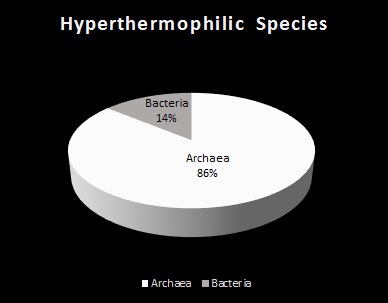
III.a-1Aη.) Thermoacidophiles
| Domain |
Genus & Species |
Ratio |
σ |
ρ |
%>H0 |
| Archaea |
Blank |
1:1 |
1/2 (50%) |
1/2 (50%) |
0% |
| Bacteria |
Blank |
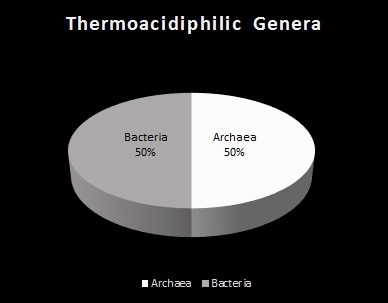
| Domain |
Genus & Species |
Ratio |
σ |
ρ |
%>H0 |
| Archaea |
Blank |
1:1 |
1/2 (50%) |
1/2 (50%) |
0% |
| Bacteria |
Blank |
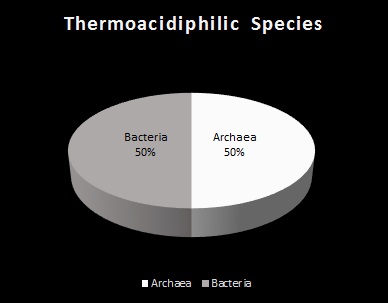
III.a-1Aθ.) Thermobarophiles
| Domain |
Genus & Species |
Ratio |
σ |
ρ |
%>H0 |
| Archaea |
Blank |
1:1 |
1/2 (50%) |
1/2 (50%) |
0% |
| Bacteria |
Blank |
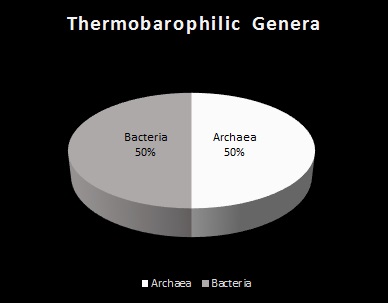
| Domain |
Genus & Species |
Ratio |
σ |
ρ |
%>H0 |
| Archaea |
Blank |
1:1 |
1/2 (50%) |
1/2 (50%) |
0% |
| Bacteria |
Blank |
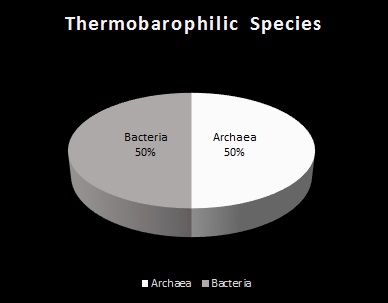
III.a-2Aι.) Totals for Planetary Extremes
General count
| Extreme |
Domain |
Number |
Ratio |
σ |
ρ |
%>H0 |
| Acidity |
Archaea |
18 |
18:7 |
7/25 (28%) |
18/25 (72%) |
44% |
| Bacteria |
7 |
| Alkalinity |
Archaea |
6 |
16:1 |
1/16 (6.25%) |
15/16 (93.75%) |
87.5% |
| Bacteria |
1 |
| Salinity |
Archaea |
|
|
|
|
|
| Bacteria |
|
| High Pressure |
Archaea |
6 |
6:1 |
1/7 (14%) |
6/7 (86%) |
72% |
| Bacteria |
1 |
| Heat |
Archaea |
18 |
6:1 |
1/7 (14%) |
6/7 (86%) |
72% |
| Bacteria |
3 |
| Total |
Archaea |
|
|
|
|
|
| Bacteria |
|
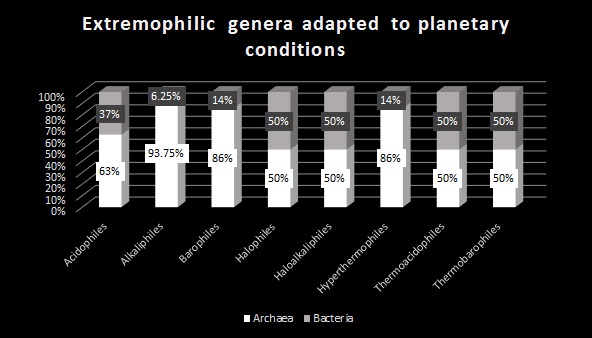
Archaeal genera goodness-of-fit
| Extremophile type | Observed | Expected | O-E | (O-E)2 | (O-E)2/E |
| Acidophilic | 18 | 12.5 | 5.5 | 30.25 | 2.42 |
| Alkaliphilic | 16 | 8 | 8 | 64 | 8 |
| Barophilic | 6 | 3.5 | 2.5 | 6.25 | 1.79 |
| Halophilic | | | | | |
| Haloalkaliphilic | | | | | |
| Hyperthermophilic | 18 | 10.5 | 7.5 | 56.25 | 5.36 |
| Thermoacidophilic | | | | | |
| Thermobarophilic | | | | | |
| X2= | |
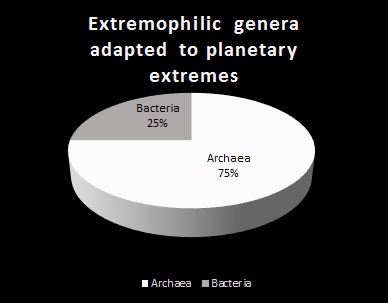
Special count
| Extreme |
Domain |
Number |
Ratio |
σ |
ρ |
%>H0 |
| Acidity |
Archaea |
18 |
18:7 |
7/25 (28%) |
18/25 (72%) |
44% |
| Bacteria |
7 |
| Alkalinity |
Archaea |
6 |
16:1 |
1/16 (6.25%) |
15/16 (93.75%) |
87.5% |
| Bacteria |
1 |
| Salinity |
Archaea |
|
|
|
|
|
| Bacteria |
|
| High Pressure |
Archaea |
6 |
6:1 |
1/7 (14%) |
6/7 (86%) |
72% |
| Bacteria |
1 |
| Heat |
Archaea |
18 |
6:1 |
1/7 (14%) |
6/7 (86%) |
72% |
| Bacteria |
3 |
| Total |
Archaea |
|
|
|
|
|
| Bacteria |
|
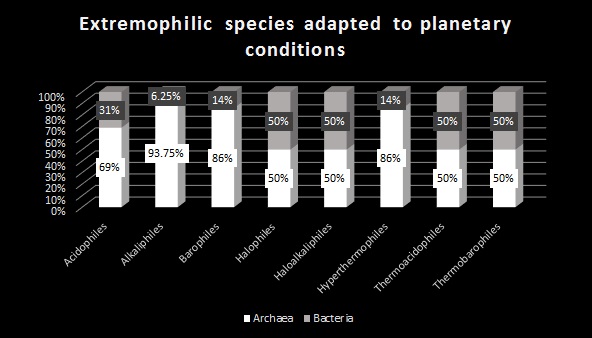
Archaeal species goodness-of-fit
| Extremophile type | Observed | Expected | O-E | (O-E)2 | (O-E)2/E |
| Acidophilic | 18 | 12.5 | 5.5 | 30.25 | 2.42 |
| Alkaliphilic | 16 | 8 | 8 | 64 | 8 |
| Barophilic | 6 | 3.5 | 2.5 | 6.25 | 1.79 |
| Halophilic | | | | | |
| Haloalkaliphilic | | | | | |
| Hyperthermophilic | 18 | 10.5 | 7.5 | 56.25 | 5.36 |
| Thermoacidophilic | | | | | |
| Thermobarophilic | | | | | |
| X2= | |
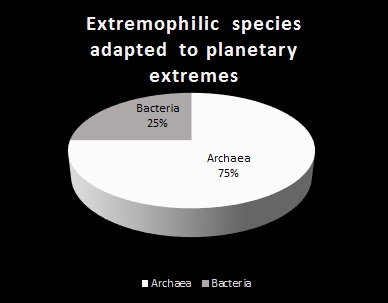
III.a-1B.) Adaptations to Spacial Extremes
III.a-1Bα.) Radioresistant Prokaryotes
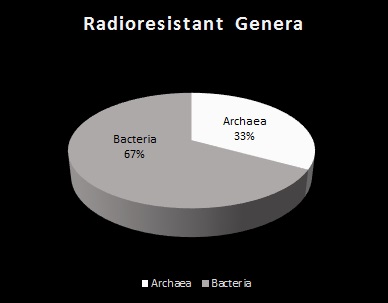
| Domain |
Genus & Species |
Ratio |
σ |
ρ |
%>H0 |
| Archaea |
Blank |
1:1 |
1/2 (50%) |
1/2 (50%) |
0% |
| Bacteria |
Blank |
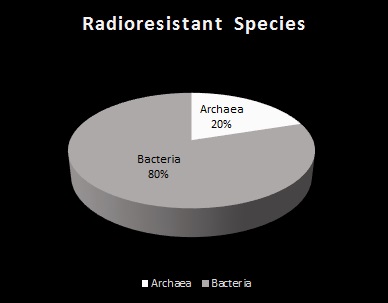
| Domain |
Genus & Species |
Ratio |
σ |
ρ |
%>H0 |
| Archaea |
Pyrococcus furiosis |
1:4 |
1/5 (20% |
4/5 (80%) |
60% |
| Haloferax volcanii |
| Natrialba magadii |
| Thermococcus gammatolerans |
| Bacteria | Bacillus subtilis |
| Bacillus atropheus |
| Bacillus thuringiensis |
| Bacillus cereus |
| Bacillus megaterium |
| Deinococcus radiodurans |
| Escherichia coli |
| Rubrobacter sp. |
| Achromobacter sp. |
| Acinetobacter sp. |
| Alcaligenes sp. |
| Enterococcus sp. |
| Micrococcus sp. |
| Pseudomonas sp. |
| Staphylococcus sp. |
| Streptococcus sp. |
(Abrevaya et al., 2011)
(Bucker & Horneck, 1970)
(Horneck, 1971)
(Nicholson, et al. 2005)
III.a-1Bβ.) Xerophilic Prokaryotes
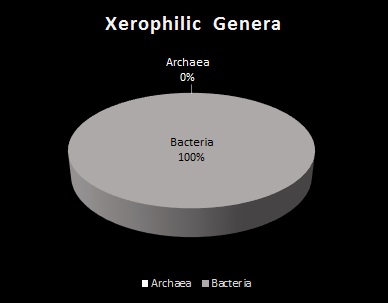
| Domain |
Genus & Species |
Ratio |
σ |
ρ |
%>H0 |
| Archaea |
Blank |
1:1 |
1/2 (50%) |
1/2 (50%) |
0% |
| Bacteria |
Blank |
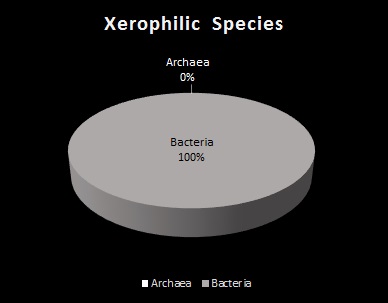
| Domain |
Genus & Species |
Ratio |
σ |
ρ |
%>H0 |
| Bacteria |
Bacillus subtilis |
2:0 |
0/2 (0%) |
1/1 (100%) |
100% |
| Escherichia coli |
III.a-1Bγ.) Cryophilic Prokaryotes
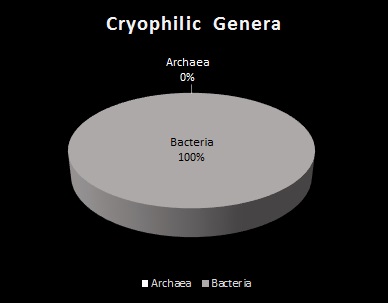
| Domain |
Genus & Species |
Ratio |
σ |
ρ |
%>H0 |
| Archaea |
Blank |
1:1 |
1/2 (50%) |
1/2 (50%) |
0% |
| Bacteria |
Blank |
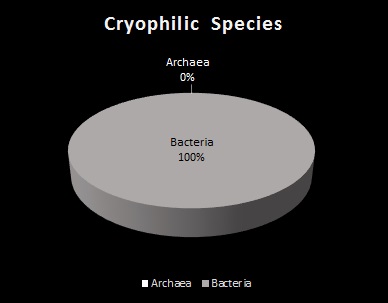
| Domain |
Genus & Species |
Ratio |
σ |
ρ |
%>H0 |
| Bacteria |
Bacillus subtilis |
2:0 |
0/2 (0%) |
1/1 (100%) |
100% |
| Escherichia coli |
III.a-1Bδ.) Hypobarotolerant Prokaryotes

| Domain |
Genus & Species |
Ratio |
σ |
ρ |
%>H0 |
| Archaea |
Blank |
1:1 |
1/2 (50%) |
1/2 (50%) |
0% |
| Bacteria |
Blank |
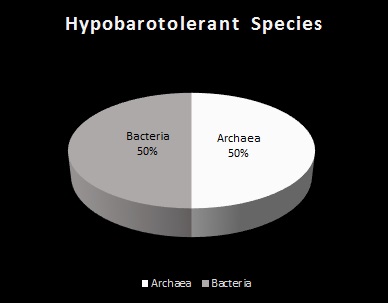
| Domain |
Genus & Species |
Ratio |
σ |
ρ |
%>H0 |
| Archaea |
Blank |
1:1 |
1/2 (50%) |
1/2 (50%) |
0% |
| Bacteria |
Blank |
III.a-1Bε.) Totals for Spacial Extremes
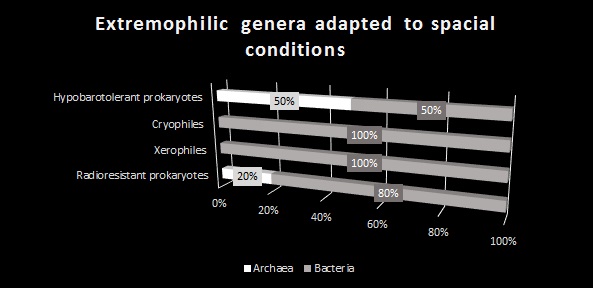
| Domain |
Genus & Species |
Ratio |
σ |
ρ |
%>H0 |
| Archaea |
Blank |
1:1 |
1/2 (50%) |
1/2 (50%) |
0% |
| Bacteria |
Blank |
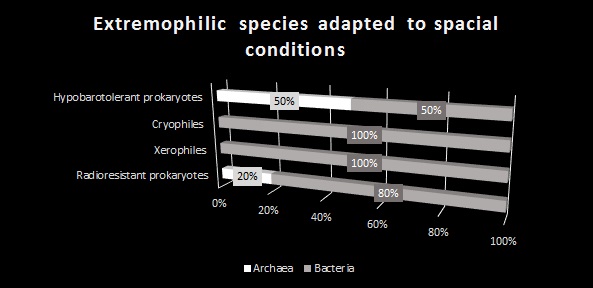
| Extreme |
Domain |
Number |
Ratio |
σ |
ρ |
%>H0 |
| Radioactivity |
Archaea |
4 |
4:1 |
1/5 (20%) |
4/5 (80%) |
60% |
| Bacteria |
20 |
| Hyperacceleration / Hypergravity |
Archaea |
|
|
|
|
|
| Bacteria |
2 |
| Low Pressure |
Archaea |
|
|
|
|
|
| Bacteria |
|
| Cold |
Archaea |
|
|
|
|
|
| Bacteria |
|
| Drouth |
Archaea |
0 |
2:0 |
0/2 (0%) |
1/1 (100%) |
100% |
| Bacteria |
2 |
| Total |
Archaea |
|
|
|
|
|
| Bacteria |
|
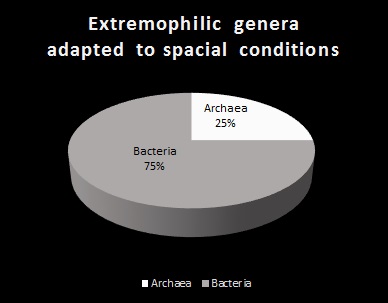 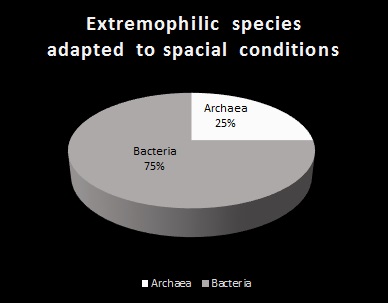
III.a-1C.) Totals for Prokaryotic Extremophiles

| Extreme |
Type |
Ratio |
σ(%)<(ρ=100%) ≈ |
ρ ≈ |
%>H0 |
| Acidity |
Planetary |
18:7 |
7/25 (28%) |
18/25 (72%) |
44% |
| Alkalinity |
16:1 |
1/16 (6.25%) |
15/16 (93.75%) |
87.5% |
| Salinity |
|
|
|
|
| High Pressure |
6:1 |
1/7 (14%) |
6/7 (86%) |
72% |
| Heat |
6:1 |
1/7 (14%) |
6/7 (86%) |
72% |
| Radioactivity |
Spacial |
1:4 |
1/5 (20%) |
4/5 (80%) |
60% |
| Hyperacceleration / Hypergravity |
|
|
|
|
| Low Pressure |
| Cold |
| Drouth |
2:0 |
0/2 (0%) |
1/1 (100%) |
100% |
Archaeal goodness-of-fit
| Extremophile type | Observed | Expected | O-E | (O-E)2 | (O-E)2/E |
| Planetary | 75% | 50% | 25% | 125% | 75% |
| Spacial | 25% | 50% | -25% | 125% | 75% |
| Df= | 1 |
| X2= | 0.075 |
Bacterial goodness-of-fit
| Extremophile type | Observed % | Expected % | O-E | (O-E)2 | (O-E)2/E |
| Planetary | 25 | 50 | -25 | 125 | 2.5 |
| Spacial | 75 | 50 | 25 | 125 | 2.5 |
| Df= | 1 |
| X2= | 5 |
| Extremophile type | ρ | H0 | ρ-H0 | (ρ-H0)2 | (ρ-H0)2/H0 |
| Acidophile | | | | | |
| X2= | |
III.a-1D.) Limitations on Methodology
General and special counts performed with described genera and species are necessarily problematic, for several reasons:
1.
|
Species and genera are largely arbitrary, especially in prokaryotes.
|
2.
|
The number of genera and species can change.
|
3.
|
Performing the count is difficult. Even under ideal circumstances (i.e., a perfect, non-arbitrary, universally applicable criterion for determining taxonomic rank, complete genomic knowledge of every living organism on the planet, phylogenies already well-determined and described in the published literature, and every species' tolerances and optimal growth conditions studied in painstaking detail and accurately described) it would be a monumental task to sift through and pore over the seemingly infinite number of papers, journal articles, and books published on the subject in order to count every genus and species ever described.
|
4.
|
General and special counts might not mean much. Even under ideal circumstances and with a complete count performed, it's questionable how useful this information would truly be. Bacteria seem to have inhabited the planet for at least 3.5 GA. There has been ample opportunity for Archaea and Bacteria to adapt to every conceivable condition on this planet, so these tendencies could be mere coincidence. While some groups of Archaea and Bacteria certainly appear to contain preponderances of certain varieties of extremophile, many of these adaptations co-evolved in diverse lineages, and are not always indicative of common ancestry. Additionally, genes involved in "planetary" extremophily seem in some cases related to genes involved in "spacial" extremophily. Furthermore, many of these genes were acquired via LGT (Fuchsman, &al. 2017; Herbold et al., 2017).
|
The conceit here is that the "overal theme" regarding which domain seems to be better at adapting to certain sorts of extremes is indicative, in a very general way, of evolutionary history.
References
|


































